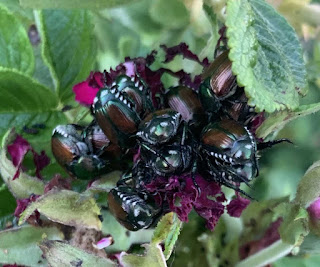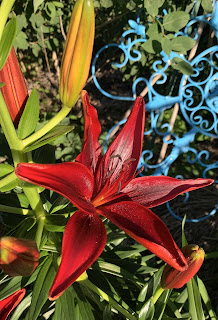Folks, I'm confused about what's happening with Feedburner and email subscriptions to this blog at the end of the month, but in an attempt to keep subscribers, if you stop getting emails from this blog, keep coming back to the original at https://kansasgardenmusings.blogspot.com until I get the subscription fixed, or try the Feedburner feed direct at http://feeds.feedburner.com/blogspot/ZSQTuT
Though an old gardener, I am but a young blogger. The humor and added alliteration are free.
Thursday, July 22, 2021
Saturday, July 17, 2021
Changelings and Oddities
When one gardens long enough, and within a large enough garden, mislabeled plants and unexpected seedlings and woebegone cultivars will eventually apparate at will and often in surprising numbers and places. And I'm not referring to the occasional 'Doctor Huey' rootstock that takes the place of your favorite rose after a long cold winter, nor to the frequent peony seedlings that I encounter in the garden and have spoken of before. I'm talking specifically about those Flying Dutchman- and Mary Celeste-type mysteries that befuddle the mind and are spoken of later in soft-whispered legends after nightfall.This Viburnum lantana pictured here and, at fruit, above, was once a green and gold-leafed variegated form that pleased me so much for a few years and has now been replaced by this more bland-leafed but still beautiful shrub. The original plant just seemed to wither and die two years ago as this changeling sprung up a couple of feet closer to the edge of the bed. I don't know if this imposter is a seedling or some rootstock from the plant I purchased, but the taller it grew, the more the original plant faded.I'm never surprised when a variegated plant gets overwhelmed by a reversion to a fully-chlorophyll-ed mutation, having seen it in sedums and euonymus, and lots of other perennials, but I was initially disappointed at the loss of the variegation in the V. lantana. Now, however, I'm reconsidering that disappointment while the contrast of foliage and bright red fruit is providing a fine ornament to the garden, whether the weather is wet and cloudy, as above, or bright and sunny, as it was this morning. A gardener should never look a gift wayfaring shrub in the seed head, to mangle a phrase.And then there are the surprise volunteer seedlings of other plants than peonies in the garden. I recently noticed that this brassy yellow daylily has sprung up in a bed composed entirely of irises (with only a few Asian lily bulbs scattered among them), and I have no idea how it got there. Now, granted, some of these iris were moved from a bed that contained both daylilies and irises, but there are several reasons I don't think it was accidentally just transplanted.
First, this volunteer seems to be growing in the middle of the 5 or 6 year old iris clump and it was never there before. Second, there are no other yellow-ish daylilies in my garden, anywhere, that are identical enough to be the parent clump. The most similar daylily I have at present is 'Hesperus', the 1950 Sprout Medal winner, but the latter has wider petals, is a little less brassy, and is more fragrant than my garden-crashing volunteer. No, I think this is a new daylily, a random seed scattered by a bird or rodent that happened to like the soil here.
So, feel free to compare and contrast, 'Hesperus' above at right and the brassy interloper here at left, but I'm certainly not going to complain at a free daylily. I'll move it, this fall, to a place on its own, perhaps into a new bed with other volunteer seedlings of my garden. I consider it, as I stated before, an afterlife effort to drive the next owner crazy as they try to identify the plant or its provenance from my messy garden notes, a vain attempt to continue to influence the garden from places beyond. If gardeners can't find satisfaction in this life, it's one way to have a good laugh in the next.
 |
| 'Hesperus' |
 |
| My volunteer daylily |
Sunday, July 11, 2021
The Surrender of ProfessorRoush
When the detailed annals of twenty-first century gardening history are collected and indelibly written to the internet, today will be noted as the day that ProfessorRoush grudgingly conceded his unwilling submission to the Japanese Beetle horde. I have lost my solo battle here on the Kansas Flint Hills, completely and irrevocably, crushed by the sheer prolific mass of beetle fertility. How many beetles do you count on the single 'Hanza' flower at the upper left? There are at least 14 engaged there in disgusting Caligulan debauchery by my count.
I wave the white flag at last, an unworthy descendent of the heros at Thermopylae, Masada, and the Alamo. Despite twice-daily rounds of the battlefield under the searing summer sun, hand-picking and crushing the chitinous slobs as they fornicated in their own frass, and occasional mass desperate dispersals of chemical weapons, I can no longer pretend to be winning and must face defeat. I know the war was lost long ago in the eastern and southern United States, but the battlefront continues its westward move. The closely-cropped beetle mass at the top is only the most visible today. Looking at the greater picture (at right) tells the true story, with smaller numbers of beetles on all the nearby blossoms, foreground and background. At night, I dream now only of the crunch of the beetle masses as they feast on the roses, of their laughter during coitus in the bright Kansas sun.
I blame my defeat on many factors, not the least of which is lack of a national sense of emergency. Forget the concerns of ecology and species diversity, Japanese Beetles hold no value to the world. The extinction of these lazy disgusting creatures would make no measurable impact on the world's ecology. They have no enterprise, no natural predators, no redeeming virtues to promote their preservation, seemingly existing for the sole purpose of consumption, defecation, and procreation. Where are, I ask, the chemists to create a poison aimed directly at the demise of this sole species? Where are the enterprising engineers to envision a fleet of affordable micro-drones capable of capturing beetles to transport and release in the fires of Hell? Where are the biologists to create infertile clouds of male beetles to slow their spread, or to genetically manipulate a lethal virus specific to Japanese Beetles ? Where is, Lord Darwin, the evolution of the insectivore who views beetles and beetle frass as a delicacy?
Future minstrels will not sing ballads to the losing effort of ProfessorRoush, but upon reflection I take solace that I am a true descendent of those at Masada and the Alamo. After all, despite their valiant and principled stands, they lost too, surrounded by enemies too numerous to count, without aid from the greater world. If there is hope for the gardening world, it is in Old Garden Roses, resistant to Rose Rosette disease and too early to be ravished by Japanese Beetles, and also in daylilies. I leave you with this 'Sonic Analogue' daylily, seemingly immune at present to the beetle appetites. I may have laid down my weapons, but I keep hope that beetle predators will evolve faster than beetle defenses and these daylilies will remain to brighten the rest of my summer days.
 |
| Poor 'Hanza' |
 |
| Beetles on 'Martin Frobisher' |
Today's pyrethrins and insecticidal soaps are worse then worthless on adult beetles. Yesterday I drenched these beetle clumps directly in modern insecticidal death and an hour later, they still moved and defecated on poor virginal white 'Blanc Double de Coubert' at abandon. I dream, at times, of finding and deploying an old bottle of DDT. Would it be worth a Silent Spring or three to rid the earth of Japanese Beetles? I hear now only, in my mind, the Beetle Voldemort laughing at poor Professor Dumbledore; "You've lost, old man."
 |
| Daylily 'Sonic Analogue' |
Saturday, July 3, 2021
Sunshine, Lilies, and Beetles
ProfessorRoush has been waiting breathlessly for these 'Kaveri' lily buds to open, desperately afraid that a strong wind or the neighbor's dog would take them down prior to their display. They seem to have self-seeded or spread over about a 10 foot area and they're all strong and healthy. Not bad for a free gift from a gardening company!
And then, somewhere in the back garden, this first of Asiatic's paints it's blood-red way among my viburnums. I always see this lily first, only to watch it fade as the rest come on.
And other lilies are holding sway right now, the taller accompaniment to the daylilies which are coming in. To the left, Orientpet 'Purple Prince' holds a proud place as the protector of a 'Beautiful Edging' daylily on my front walk.
Nearby, this group of 'Yellow Dream' and 'Purple Prince' (below) will brighten up the area in front of the garage for the next two weeks. You know from my previous posts how much I wait for and love 'Yellow Dream'. Downwind from this group is always a sweet fragrance treat that I have to stop each time and admire. 'Purple Prince', himself, is maybe not so pretty (at right), but he's a strong and stalwart fellow in the garden.
Last but not least, this is obviously not on a lily, Orientpet or Asiatic, but I always try to mark the first arrival of Japanese beetles in this blog so that I can keep track of them. And here one is, first found on June 28, 2021, on top of 'Fru Dagmar Hastrop', frass sprinkled among the petals. Thankfully, the disgusting creatures prefer this rose and 'Blanc Double de Coubert' and leave the others alone. The spray I'm using doesn't seem to make any difference, sadly. I'm just hand-picking and gleefully smashing under my heels. Quite a sad comment on the activity of an otherwise peaceful gardener.
Subscribe to:
Comments (Atom)










